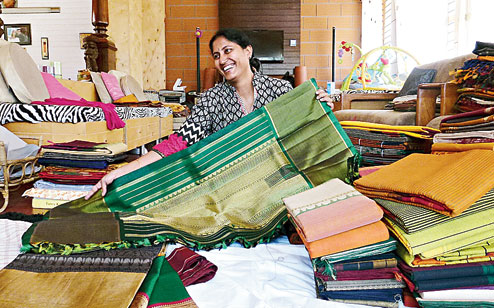 |
 |
| Owner’s pride: Meena Mahesh (top) and a Kanchipuram in the making. Pictures: Manjula Sen |
For three generations, Devasi Sikamani’s family produced the most beautiful of Kanchipuram saris. But Sikamani, 32, has opted out. Four years ago, he gave up the family tradition to start a grocery shop.
“Weaving does not pay. With the grocery store I am doing well. There is enough for the whole family. My parents have also stopped weaving,” he says.
Sikamani began weaving when he was 12, assisting his parents. His father Munnuswami started as a weaver when he was 15 and was later joined by Renuka in plying the loom when they were married. “I would have liked to have passed it on to a younger generation but no one is coming forward to learn it,” says Sikamani.
Kanchipurams (or Kajeevarams, as they are popularly known) are fast vanishing from the eponymous town in Tamil Nadu. Earlier, one out of every four shops on each street in the town was a manufacturer, says T. Ravisankar, whose grandfather Rajamanicka Mudaliar started the two-storeyed wholesale S. Rajamanicka Mudaliar Company on Pallikoodathan Street nearly 100 years ago. Today, there are only 10 shops on the street, he says.
Sari collector Meena Mahesh is at the first-level display room of the store, running an expert eye as she rifles through silks and cottons. At her decisive nod, an attentive shop hand adds one more sari to a rising stack of Kanchipurams. Her final tally is over 20. “Some of these are not easily available,” says Meena, the proud owner of over 150 Kanchipurams, some in weaves that are a collector’s dream.
She knows its worth, for Kanchipuram may be a lost art in five years. Locals rue that there just aren’t enough weavers to keep the supply chain for the celebrated sari running.
Already, the Chettinad version of the sari has all but disappeared. The temple and the contrast borders are becoming costlier and scarce because they take more hands to weave. Fewer cotton and silk handloom saris that may take a month or more for a family of weavers to produce are being turned out, leaving imitations in their wake.
Government policy banned power looms in Kanchipuram in an unsuccessful bid to protect handlooms, which account for only 10 per cent of production, says A. Thangaiarasu, who has been in the handloom business for decades. A person can weave two saris a day on a power loom but it takes four people four days to weave one handloom sari.
Kanchipuram saris are among 22 traditional items that are prohibited on power looms. “But who can control what goes on in someone’s home,” asks master weaver P.T. Gopinath. “There are a lot of fakes in the market.”
 |
| The industry will survive only five years. Of the 50,000 looms that were there once, only 10,000 survive. — Master weaver Gopinath |
What makes the Kanchipuram sari special is the interlocking weaving technique and multi ply thread that gives it its unique heft. Though it has a Geographical Indication Certification, it draws on inputs beyond its territory: its zari is from Surat, silk from Bangalore, Chikkaballapur and Chennapatna in Karnataka, and cotton from Coimbatore.
The sari has always been in demand across the country, finding special place in weddings. The Mudaliar family store, for instance, supplies to stalwart retailers and is commissioned by clients such as finance minister P. Chidambaram for weddings. “Even the sari that Aishwarya Rai wore for her wedding was sourced from here by a Delhi shop,” says Ravisankar.
But the number of silk sari shops in Kanchipuram has dropped from 500 to 50, and cotton is down from 300 to 10, says R. Rajamanicka’s Vignesh, who has just joined the family business. “We are the only wholesalers for cotton; everyone has given up the business. Only we are surviving,” adds the 23-year-old.
Its shortfall is being felt across the country. In Calcutta, Ishwar Thakwani and his brother, who steer K. Bhojraj Creations on Rashbehari Avenue, are feeling the pinch. The Thakwanis stock up from the Mudaliars, but also personally foray to Kanchipuram every few weeks to scout as far as 50-60km into the heartland for weavers.
“Earlier, labour was cheap. We would get 500 pieces in one month. Now we are lucky if we get 25 saris in three months,” says Ishwar Thakwani. Singer Arati Mukherjee and the Iyer sisters, led by Usha Uthup, are his customers.
At the root of the vanishing Kanchipuram sari is the dwindling number of weavers. For the younger generation, weaving is no longer a viable option. “No one wants to marry a weaver for the bride will also have to help with the weaving. Even weavers would prefer to send their children to colleges rather than looms,” says Thangaiarasu. “For their children even the sound of the loom at home is annoying,” adds Gopinath.
About 32km from Kanchipuram is Sriperumbudur and then Chennai, a route that is lined with auto, electronics and telecom factory hubs of companies such as Hyundai, Ford, Saint-Gobain, Mitsubishi, Nokia, Dell, Ashok Leyland, Samsung, Nissan and BMW. The lure of regular jobs and upward mobility has further stoked the desertion from pit looms, where incomes are low. Weavers’ wages average out to Rs 5,000 a month per sari.
Even two decades ago, weaving a Kanchipuram was a matter of pride. Take the case of Gopinath, who came from a farming family. When he was 15, he began to work as an apprentice with a master weaver in a silk shop. Within a decade he too had become a master weaver — the go-between a wholesaler and the artisan.
Gopinath, 35, started with five looms and now has 120. But only three of his 120 weavers are willing to touch intricate designs for saris that sell for Rs 15,000; most would spin Rs 8,000-saris which are less resource consuming.
The industry, he predicts grimly, will survive only five years. Of the 50,000 looms that were there once, he estimates that only 10,000 survive.
Not everybody is as pessimistic. Vignesh believes the future of their business is bright. Modernisation, he adds, will come through communication and sales through online display.
Those in the business wonder if Kanchipuram will go the Dharmavaram way. Dharmavaram, in Andhra Pradesh, produces saris in a “factory style”, with about 250 craftsmen working for eight hours a day in a shed. Thangaiarasu argues that such a system could mean a regular income for weavers.
But Gopinath believes that would be the final blow to the craft, “Kanchipuram saris depend on interpersonal relationships which cannot be replicated in a factory,” he says.
As Gopinath steps out from a weaver’s cottage, we learn that his wife doesn’t own a Kanchipuram sari. It is too expensive. “Otherwise who will not like a Kanchipuram sari?” he asks.











